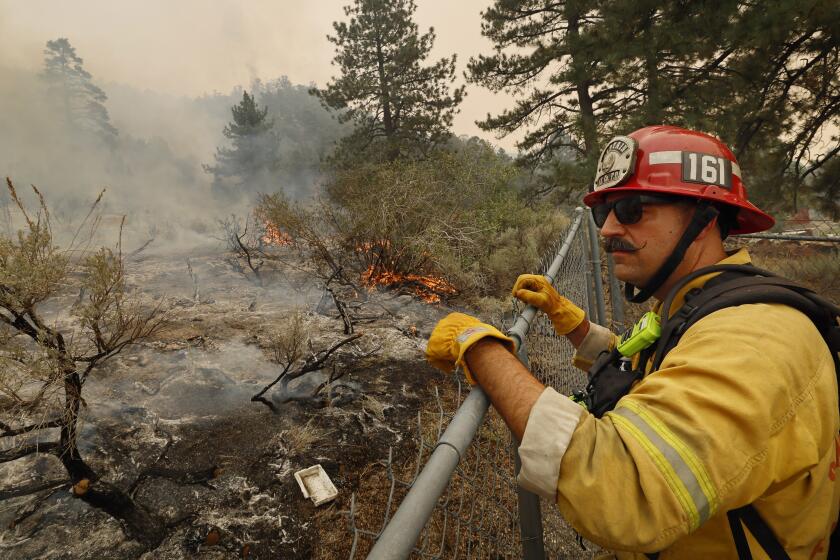Homelessness in the Valley / Surviving Day by Day : Rejection of Van Nuys Shelter Shows Solutions Often Transient : Conflict: Residents’ opposition killed the proposal. Citizens and officials try to balance homeowners’ concerns and concern for those who have no home.
In a dilemma faced by the homeless citywide, Van Nuys residents who have long complained of aggressive panhandlers and vagrants sleeping in their entryways last month shot down a proposed 150-bed shelter that would take some of those people off their streets.
The drama played out quietly, garnering little attention outside the Sepulveda Boulevard neighborhood near Saticoy Street. But it highlights the competing interests and philosophies often involved with homelessness.
“When we are threatened with something that has an adverse effect on our neighborhood, we react to it,” said Van Nuys Homeowners Assn. President Don Schultz, who led the fight against the shelter.
Schultz said the facility would lure more homeless people to the area. He added that he has an obligation to represent his constituents, who are homeowners, not the homeless.
Proponents of the shelter dropped the idea because of opposition by Schultz and his group.
Said one city official familiar with the case: “People call and say, ‘Get rid of the transients,’ and when you come up with a solution, a lot of times it’s thrown back in your face.”
The Van Nuys case is not uncommon, homeless advocates say, with both citizens and politicians struggling to balance concerns for the homeless and concerns of homeowners.
“It’s a problem throughout the city,” said the city official.
The makeup of the San Fernando Valley, however, with its diverse communities and no central authority, may exacerbate the already difficult task of reducing homelessness.
The Valley is “much more fragmented” than other parts of Los Angeles, said Jeff Farber of the L.A. Family Housing Corp., which proposed building the Van Nuys shelter. “With the geographic structure of the community, people are slower to accept they have a problem.”
And that problem is growing, everyone agrees.
“I see homelessness in Woodland Hills and Encino, which seemed immune in the past,” said Ken Bernsteing, spokesman for Councilwoman Laura Chick.
A few communities have taken small steps to address the problem. Studio City and Van Nuys, for example, both encourage residents to offer panhandlers cards that list homeless services rather than giving money.
Some neighborhoods have been receptive to shelters. And there are groups working to dispel stereotypes of the homeless in the hope that understanding will eventually lead to a solution.
But final decisions are usually decided by City Council members, who face the dilemma of trying to both serve voters and care for the homeless.
The police face a similar dilemma: Residents call with complaints and ask officers to arrest people for sleeping in doorways, even if they have nowhere else to go.
“We really don’t want to arrest them because we realize these people are down on their luck,” said Sgt. Jim McMurray of the Los Angeles Police Department’s West Valley Division.
Police raids are conducted occasionally, but they do little more than force the homeless from one park or underpass to another, experts say.
While homelessness has increased in the Valley in recent years, the bureaucracy designed to combat it has grown as well--some say to the point of becoming nearly as unwieldy as the homeless problem itself.
Federal, state, city, county and private groups all fund Valley programs for the homeless, but there is no single organization to coordinate the effort.
The city of Los Angeles, in fact, filed a lawsuit against Los Angeles County in 1987, claiming the county was failing in its state-mandated obligation to provide for indigent relief. The county, in turn, placed blame on the state and city.
Ironically, as a result of the legal wrangling, an interagency organization called the Los Angeles Homeless Services Authority (LHASA), was created to coordinate the homeless relief effort.
Homeless advocates say improving coordination among agencies is nearly as important as getting more funding for job programs and other aid packages.
And all agree that more funding is needed. Some is coming from the Clinton Administration, said LAHSA analyst Arnold Garcia. But at the same time, local funding is dwindling, he said.
At the moment, he said, “We’re not getting ahead.”
More to Read
Sign up for Essential California
The most important California stories and recommendations in your inbox every morning.
You may occasionally receive promotional content from the Los Angeles Times.










